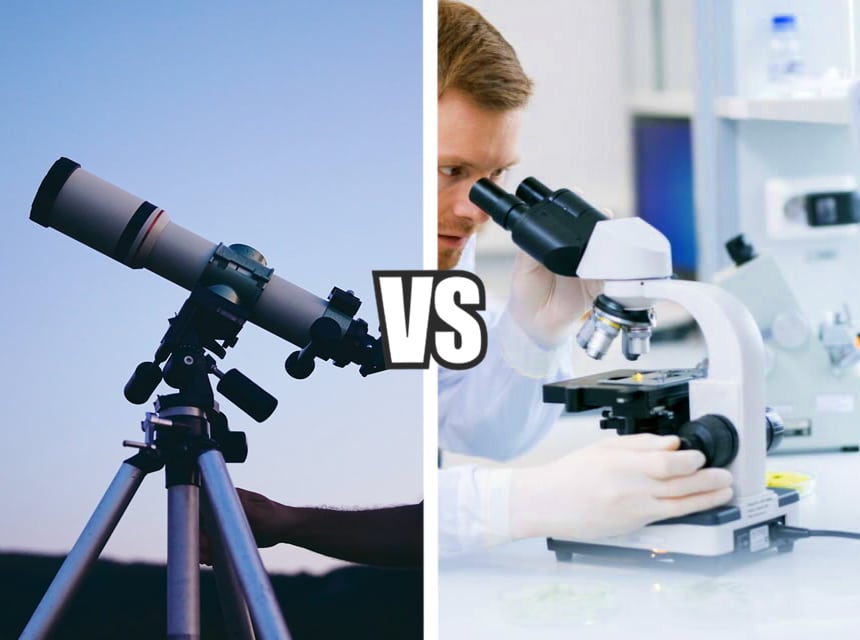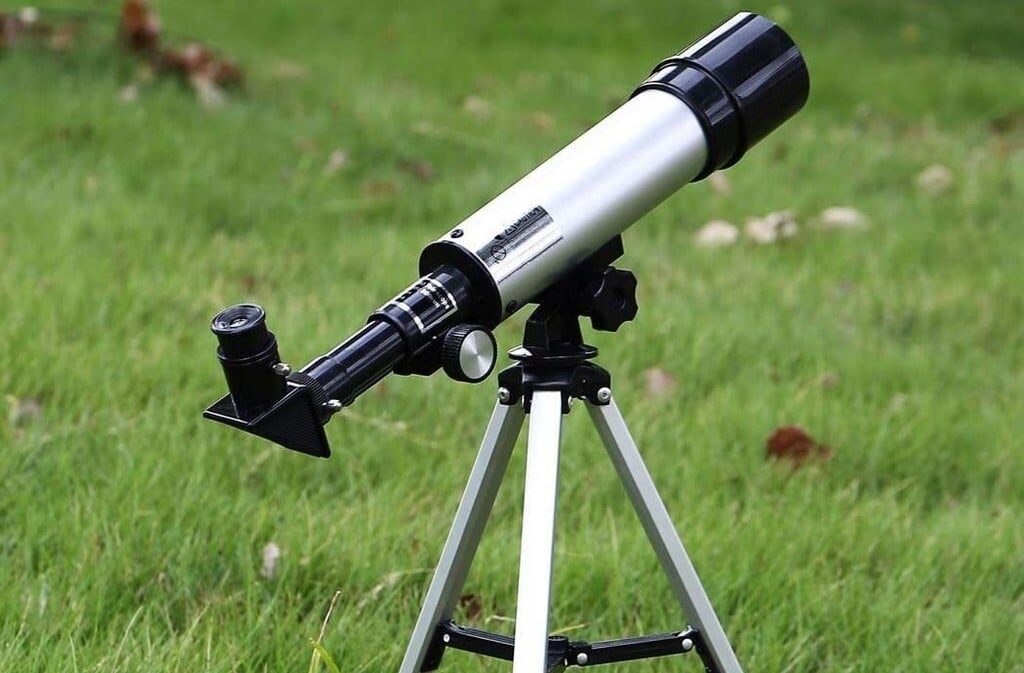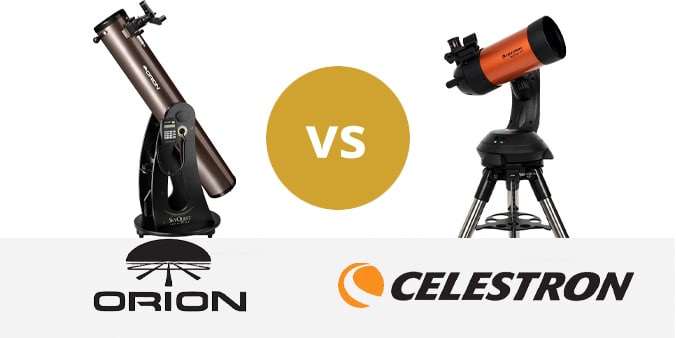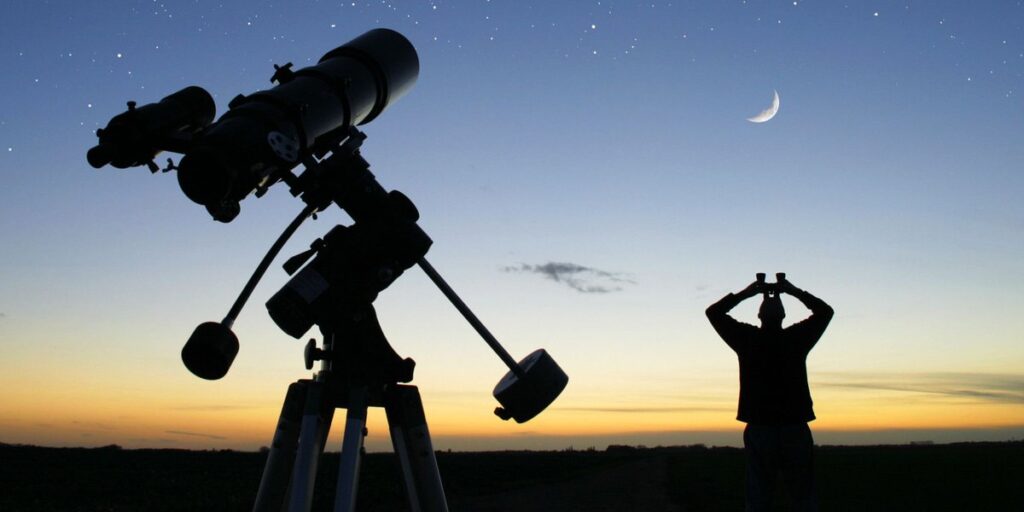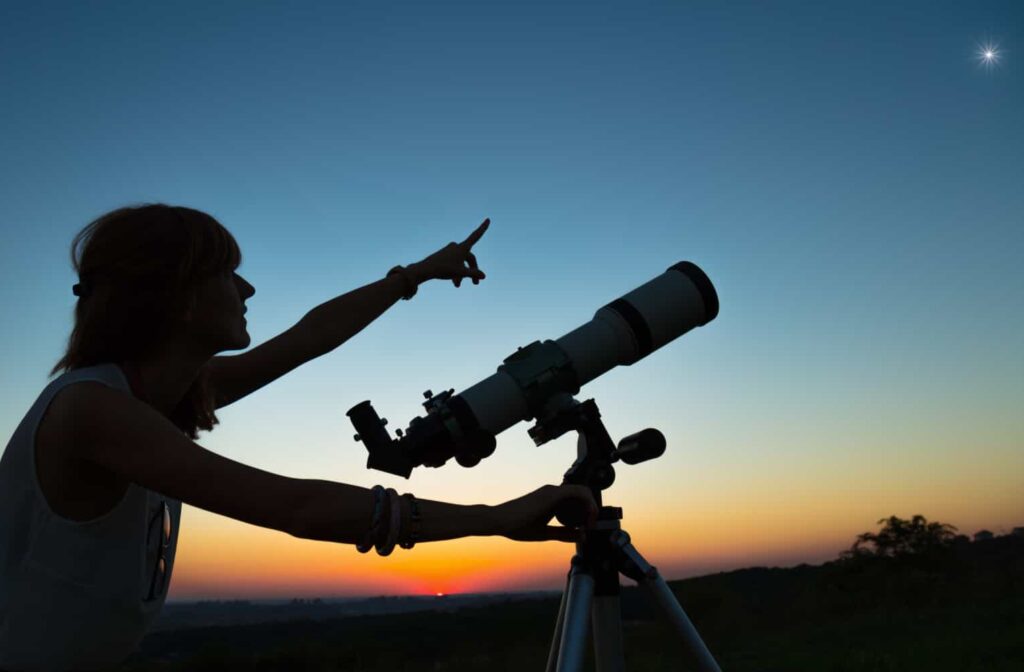

Finding that perfect budget telescope is not as easy as you might think. Despite being affordable, these should be of high enough quality to make watching the night sky a fantastic experience. We understand the struggle, and so we took the initiative to single out a few of the best telescopes under $100 that you can find on the market.
We have reviewed all the products below so that you know what you are getting into beforehand. The type of telescope is an important consideration, but in this price range, we were able to include mainly reflector telescopes on our list, except for the last one. It is also crucial to consider measurements such as the aperture, focal length, and ratio, since the output changes with them. A strong mount will ensure that your telescope stays in place. And if you’re looking to take your telescope with you outdoors, it should ideally be small and lightweight.
Other features: Galileo Mars Eye Electronic Finderscope; CBI Planetarium CD ROM; accessory tray with slots on a tripod to place 4 eyepieces or lenses;
If you are looking for a budget telescope that will give you premium results, then you cannot do better than the Galileo FS-80Z. The optical tube assembly of this model has an 800mm focal length. The telescope has a primary mirror that measures 80mm in diameter. Its heavy-duty mirror cell has push / pull collimation screws.
You will find that the Galileo FS-80Z is fixed on an altitude azimuth yoke mount. As a result, it is easy to move the telescope left and right as well as up and down without much hassle. If you are a beginner, you will appreciate the ease of use. This Galileo model has two 1/4-inch eyepieces, measuring 6mm and 20mm, respectively.
One of the best beginner telescope under $100, the FS-80Z comes with two bonus lenses. The 16.8mm – 16mm Bonus Zoom Eyepiece will allow you to take advantage of multiple eyepieces. You will not have to switch out the less every time when you want to alter the power of your telescope. The second bonus lens is a 1.5x Erecting eyepiece that will change the image right-side-up.
The CBI Planetarium CD ROM that comes with the telescope will bring the sky and the outer space into your house. The Mount of the telescope has a slow-motion altitude adjustment rod so that you can make precise adjustments. It is connected to a sturdy, pre-assembled metal tripod that is fully adjustable. The tripod has retractable rubber feet and a slotted accessory tray where you can store your eyepieces or lenses.
Other features: 1.25in helical rack and pinion focuser; slow motion altitude adjustment rod; Cassini Planetarium CD-ROM included
Viewing the stars will bring you a lot of joy. Getting your own telescope is an excellent way of making it a hobby. The Cassini Refracting C80 Telescope C-80 is designed to provide a clear view of the sky so that you face no problems even if you are a beginner.
The optical tube assembly of this telescope from Cassini has an 800mm focal length. The telescope has a primary mirror measuring 80mm in diameter. Moreover, it features a heavy-duty mirror cell that has push-pull collimation screws. You will find that this telescope can be mounted on a sturdy altitude azimuth yoke mount. You will have no problem adjusting the telescope based on your requirement. Whether you want to move it up and down or right and left, the design of the mount will allow you to achieve that perfect angle. If you are a beginner or a casual stargazer, you will love this telescope since it is easy to use.
The mount comes with a slow-motion altitude adjustment rod so that you can make accurate adjustments without having to devote a lot of time. The telescope has a strong pre-assembled metal tripod on which it can be placed. The tripod can be adjusted in every way, and it features rubber feet, which means that you can move it easily.
The Cassini Astronomer’s C-80 Telescope uses a 1¼″ 6mm eyepiece as well as a 1¼″ 20mm eyepiece. You will also love the Cassini Planetarium CD ROM that comes packaged with this telescope since it will bring the space right into your room.
Other features: 1.25in helical rack and pinion focuser; apparent field of view of 52°; the primary mirror with 92% reflectivity and a resolving power of .86 arc seconds
Finding an affordable telescope that does the job well does not have to be an ordeal anymore. The Galileo G-80DB has managed to create a portable and lightweight telescope system that you will be able to carry anywhere. Based on the design of the affordable and convenient Dobsonian telescope, this product has a 500mm focal length and will give you excellent results.
One of best beginner telescope under $100, the G-80DB has a compact matte black finish base that looks sophisticated. Since the telescope is just 1ft. tall with a 1ft. diameter base, you will be able to place it on any stand or table easily. Create a setup that works for you. The telescope comes with an 80MM primary mirror that performs just as well as a full-size reflector telescope. It has excellent light-gathering properties but remains portable. The primary mirror is further aluminized with the help of a silicon monoxide quartz overcoat that offers 92% reflectivity.
The Galileo G-80DB optical tube assembly has a 500mm focal length. The heavy-duty mirror cell features push-pull collimation screws. The G-80DB comes with a 1 1/4″ 20mm eyepiece along with a 1 1/4″ 6mm eyepiece. They will give you an apparent field of view of 52 degrees. Galileo’s Mars’ Eye electronic Finderscope will help you get behind the telescope and target objects without losing the surrounding field of view.
Other features: 2x Barlow lens, built-in compass; moon filter; astronomy guidebook and software included
If portability is your top priority, then you do not have to look beyond the National Geographic 76/350 Compact Telescope. This Automatic telescope has a wide-field-lens, and you can carry it anywhere without any problem at all. The compact design exists in harmony with great performance.
This telescope is ideal for beginners and travelers. If you love camping and hiking, then taking a portable telescope with you will truly elevate your experience. This small but powerful Dobsonian telescope is easy to set up and use. You will have no problem figuring out how to use it. The reflective telescope can gather a lot of light from the celestial objects, giving you a clear view of the night sky.
One of the best deep space compact telescope under $100, it is pre-assembled so that you do not have to spend valuable time constructing it. Place it on a table or stand, and start exploring. It comes will all essential accessories. With a diameter of 76mm and a focal length of 350mm, this telescope will give you desired results no matter where you are. It comes with two eyepieces, measuring 6mm and 20mm, respectively.
If you want to take your stargazing hobby to the next level, you can invest in this telescope without breaking the bank. You will also get a small book with an introduction to the night sky as well as a planetarium software for your computer.
Other features: 2x Barlow lens; Celestron’s Starry Night Basic Edition Software and SkyPortal App – smartphone compatible
Investing in a portable telescope will give you an insight into the starry sky of the night. The Travel Scope 70 DX is a refractor telescope that comes with a full-height tripod as well as bonus accessories like smartphone adapters that will allow you to take pictures through your eyepiece. Being able to capture media with your Travel Scope will give you a unique chance to record what you see. Take this high-quality telescope with you on your trips and have unforgettable experiences. This is one of the best deep space compact telescope under $100.
This portable telescope kit features a 70mm refractor telescope with fully-coated glass optics, a travel backpack, and a full-height tripod. The total kit weighs only 3.3 pounds. There are two eyepieces measuring 20mm and 10mm, respectively. You will also find 2 Barlow lenses, a finderscope, and a Moon filter. Fit your telescope as well as the accessories in the bag. The tripod legs are adjustable, and you can customize the height based on your requirement. You can also place it on a table or a stand.
With the Travel Scope 70 DX, you will be able to spot celestial bodies at night. You can also use it during the day to watch birds, landscapes and wildlife. With the smartphone adapter, you can connect any smartphone to the Travel Scopes eyepiece. You will get additional magnification allowing you to capture beautiful pictures and videos. The Bluetooth shutter release will allow you to use the shutter remotely.
If you are planning to buy a budget telescope, then this buying guide will help you make the perfect choice.
Telescopes can be expensive, but you can snag some excellent telescopes under $100 if you do your market research. They can perform well and give you bang for your buck. In many cases, they also happen to be portable, which is a huge advantage. However, you should keep your expectations realistic. You might not find a telescope under $100 that has an aperture of over 80mm. If that is not a priority, you should be okay with this compromise.
Make a list of the minimum features that you would want your telescope to have, and then match them against the specifications of the models you like.
If you have just stepped into the world of astronomy, you should choose a telescope carefully. There are some features that you should definitely consider when you are picking a telescope so that you can use it properly.
There are three types of telescopes available on the market- refractors, reflectors, and catadioptrics.
Refractors like the Celestron Travel Scope 70DX come with a lens in front of the tube. They are the most common type of telescopes on the market. They are usually low maintenance, but the price goes up quickly as the aperture increases. You will find that an apochromat will give you better optical quality than an achromat of the same size. The former is more expensive. The tube lengths of refractors vary between 8 and 12 times their aperture. Refractors also tend to be more rugged.
Reflectors like the Galileo FS-80Z use a mirror that can gather and focus light. The Newtonian reflector is probably the most popular reflector telescope. Reflectors collect the light at the rear of the main tube. These tend to be the most affordable for any given aperture type. You might have to adjust the optical alignment sometimes, but the process is straightforward. If you want the maximum aperture possible for the money you spend, you should go for the reflector. Dobsonian telescopes are portable, easy to use, and extremely adorable, but their aperture ranges between 4 inches and 30 inches only.
Compound telescopes utilize a combination of lenses and mirrors to combine different features. For one, they are lightweight and have compact tubes.
Common compound telescopes are Maksutov-Cassegrains and Schmidt-Cassegrains. If you want features of both refractors and reflectors, then compound telescopes are the way to go. However, they tend to have narrower fields of view and are on the more expensive side.
One of the most features of a telescope is the aperture. A telescope’s aperture determines its light-gathering ability and controls the brightness of the image that you see. The aperture is also responsible for the resolving power and sharpness of the picture. If you know how to use the aperture to your advantage, it will improve your experience. The bigger the aperture of the telescope, the better it is for you.
While you should not expect telescopes under $100 to have very big apertures, it would be ideal to have a model with an aperture of at least 2.8″ or 70mm. The National Geographic Compact Telescope 76/350 has an aperture of 350mm.
Magnification is an important factor that you need to take into account when you are deciding whether a telescope is perfect for you. Finding the telescope that offers the optimum magnification for your requirements is where the challenge lies. Too little and too much can both be a hindrance. In order to determine your top useful magnification, there is a simple rule you can follow. It should be 50 times the telescope’s aperture in inches, or it could be twice the aperture in millimeters. If the magnification offered by your telescope satisfies either of these conditions, you are good to go.
The Cassini C-80 offers a magnification range between 40x–133x.
All telescopes have a specific focal length (FL), which marks the distance between the primary lens or mirror and the image it forms. It is not always equal to the length of the tube. You will find the focal length printed or engraved conspicuously on the front or back of the telescope. It usually varies between 400 and 3,000 millimeters. Eyepieces also come with their own focal length measurements.
The focal ratio of a telescope is the ‘speed’ of a telescope’s optics, which can be calculated by dividing the FL by the aperture. It is represented as f/number and determines the brightness of the picture. The Galileo FS-80Z has an aperture of 80mm and a focal length of 800mm, so it follows that the focal ration is f/10.
There are two types of mount that you will come across: altitude-azimuth (or “alt-az”) and equatorial. An alt-az mount works like a tripod’s pan-and-tilt head. It can move the scope up-down as well as left-right. On the other hand, equatorial mounts come with two tilted axes, such that one is aligned with the Earth’s rotational axis.
For small telescopes, the alt-az mount is usually preferable because they provide smooth slow-motion controls that allow you to make precise changes. The Dobsonian is a type of alt-az mount and is perfect for beginners. You can find it in the Galileo Dobsonian G-80DB.
Equatorial mounts are ideal for advanced users who are used to adjusting the axes properly.
If portability is an important factor for you, then you should go for lightweight models. The Celestron Travel Scope 70DX and the National Geographic Compact Telescope 76/350 are ideal for travelers because of their small size and relatively less weight. You can set them up easily on benches and tables. Heavy telescopes are not only difficult to carry, but they are also more prone to damage.
If you are looking for a telescope that goes the extra mile to make you happy, then you should look for advanced features such as Bluetooth connectivity, smartphone adapters, and more. The Celestron Travel Scope 70DX offers an excellent feature via which you will be able to capture your observations in pictures and videos. All you have to do is connect your smartphone to the scope.
All the telescopes on our list are efficient and will provide value for money, but we have three favorites.
The Galileo FS-80Z is a reflector telescope with an 80 mm aperture. The focal length of 800mm and the 40x–133x magnification ability are impressive features. You can use this telescope with multiple eyepieces. It comes with an easy-to-use tripod that has accessory slots.
The Cassini C-80 has an aperture of 80mm and a focal length of 800mm. It offers magnification between 40x–133x so that you can view celestial objects clearly.
The Galileo Dobsonian G-80DB, with its aperture of 80mm and a focal length of 500mm, is highly portable and has excellent light-gathering abilities. The primary mirror with 92% reflectivity will give you a clear view of the night sky.
Pick the best budget telescope under $100 that ticks all your boxes and gives you excellent value for your money!

